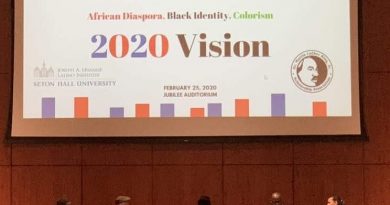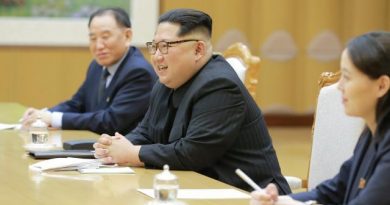Diplomacy Students Take Historic Study Abroad Trip to Cuba
By Francesca Regalado
Managing Editor
HAVANA, Cuba – Havana felt like home.
I arrived at José Martí International Airport with my Cuba seminar group on the tail end of a winter flu. But as soon as our group stood on the Malecón, Havana’s five-mile boardwalk, the warm sea air cured me instantly.
Aside from tropical climes, Spanish colonization, and American influence, Cubans and Filipinos have one striking trait in common. In the Philippines, we call it diskarte – being resourceful enough to make the best out of a bad situation. In Cuba, I saw it in the driver who fashioned a gas tank out of a plastic bottle to repair his antique 50s-era car. I saw it in the cigar rollers who sold their five free Cohibas and Montecristos a day to tourists passing through the factory for cheap to add to their meager monthly salary of $30. I saw it in the cuentapropistas, or self-employed workers, who saved remittances from relatives in the United States until they could open their own paladares, or privately-owned restaurants.
These paladares popped up only recently, when the government was forced by a stagnant economy to allow private businesses. The liberties granted so far have been minimal, but change is on the horizon.
“This is a special time in the country’s development, considering this will be the last year a Castro will be in charge of the country,” said Andrew Jordan, a first-year graduate student. Fidel Castro, who led the Cuban Revolution in 1959, died in November at 90. His brother Raul, the current president, announced that he would step down from office in 2018 to pave the way for elections.
The 24 students who took part in the seminar over spring break jumped at the opportunity to visit Cuba before it was altered by political and economic reforms – or, worse, closed off to American visitors by the Trump administration. To Daniel Bartley, a second-year graduate student who has studied at length American foreign policy during the Cold War, Cuba is “one of the lasting symbols of that period in history.”
A Family Reunion

For Joel Martinez, the Cuba trip was a true homecoming. His uncle, at 17 years old, defected from Cuba in 1967 after refusing to serve in the Castro government’s draft. Resettling in Newark, he arranged for his parents and sisters, including Joel’s mother, to join him in the United States as political refugees.
Joel’s grandmother was especially excited for him to join the Cuba seminar. “For any of her grandchildren to make the trip to the ‘motherland’ and meet one of her siblings meant the world to her,” he said.
Joel, a second-year graduate student, was encouraged by Dr. Benjamin Goldfrank to arrange the reunion. “It was important for him that the experiential aspect of the course was not lost on us,” Joel said.
“That was one of the sad repercussions of poor U.S.-Cuban relations – how difficult it made life for families living apart,” Dr. Goldfrank said.
Arranging the reunion, however, was a logistical challenge because Joel’s relatives, like many Cubans, had unreliable Internet connectivity. Fortunately, our tour guide, Adrián, was sympathetic to Joel’s goals and offered not only to let Joel use his phone to call his relatives, but also to drive Joel to their house.
“I wasn’t entirely sure what to expect since it can feel at times as though we are worlds apart,” Joel said. “That completely faded away when we saw each other and hugged for the first time.” He was particularly moved by the support of his classmates, who took pictures and videos of his family reunion.
We had one free night to explore Havana by ourselves. Joel chose to spend it at his great-uncle’s house, where they bonded while sharing stories of his grandmother as a young woman and watching the World Baseball Classic match between Australia and Cuba. (Spoiler alert: Cuba won.)
Political Controversy
The trip was almost dampened by criticism of a class picture taken at the Plaza de la Revolucion in front of the Interior Ministry, which features a large mural of the Argentine revolutionary leader Che Guevara. The Seton Hall account had written, “How are you spending spring break?” to which one user replied, “Not spending it by taking pictures in front of a communist brutal mass murderer’s mural.” Another wrote that Guevara’s mural was a “very shocking and inappropriate location for a picture,” and yet another commented that “an apology is in order to Cuban students.”

Because many people vilify Guevara while still others commend him as a revolutionary hero, “neither one of these singular narratives can fully frame the complexity of the man nor the symbol his imagery has come to embody,” said Joel. “Choosing to ignore the significance of Che’s role in Cuba and, at the same time, dilute our entire experience in Cuba to a single photo is dismissive and intellectually lazy.”
“Barack Obama and Pope Francis have stood in that same spot,” said Daniel Bartley. The picture was taken as a tribute to Obama, “under whose administration this groundbreaking, educational trip became possible for us,” added Alexandra Recupero, a sophomore.
“After the November elections, I was worried that the new president would reverse the thawing of U.S.-Cuba relations and make it impossible for the trip to go forward,” said Dr. Goldfrank, who had been planning the trip with the Joseph A. Unanue Latino Institute since January 2016.
Bypassing Red Tape
After the syllabus was vetted by the Diplomacy faculty and the Provost, Dr. Goldfrank had to contend with the Cuban government to push forward his proposed itinerary. “We had to go with an official local agency,” he said. “It was impossible to set up meetings with the University of Havana or other institutions without going through the local agency.”
The first day of business began with back-to-back sessions on opposite ends of the spectrum: a diplomatic briefing at the United States Embassy in Havana, and a lecture by a professor from the University of Havana on international law and Cuban labor laws. Both lectures were “one-sided,” said Alexandra, because the Embassy representative would not answer some questions and the professor spoke defensively about the Cuban government and its record on human rights and discrimination.
The students came to Cuba with the understanding that they would have to dig deeper and push harder to get honest answers not only from speakers, but also from the civilians they encountered. Even when we pushed, we were able to do so only to the limit of what the Cuban government would allow us to see. While we were there, for example, we did not know that rocks had been thrown at the Ladies in White, who protest every Sunday the unexplained disappearance of their relatives.
Fortunately, Dr. Goldfrank had also invited Anthony DePalma, a former foreign correspondent for The New York Times who was the Mexico bureau chief and is currently teaching journalism at Seton Hall. Prof. DePalma frequently leads the Times Journeys tour of Cuba.
“Having both Dr. Goldfrank and Prof. DePalma, two instructors who have spent their careers studying and traveling to Latin America, gave us plenty of time to reflect on our experiences as well as a better appreciation of our time in Cuba,” said Daniel.
“I am still thankful for how open Cuban locals were in our conversations,” he added. “There was no topic off the table.”
“Once we were in Cuba, we encouraged students to talk to people on their own along the Malecón, at the market, and at the University,” Dr. Goldfrank said. “I think students took advantage of those opportunities pretty well.”
Person-to-Person Exchange

One of the better-received speakers was Jorge Mario Sanchez, a professor of economics at the University of Havana whose candidness, specificity, and expertise on U.S.-Cuba relations was a refreshing change of tone. “No one asked Cubans what we want to be,” he said about the changes a full lifting of the U.S. embargo would bring. “We don’t want to become another Cancun,” he added, referring to the Mexican city by American tourists.
Many students also said they enjoyed visiting Cuba Libro, the only English-language bookstore in Havana. It was founded by Conner Gorry, an American journalist and a friend of Prof. DePalma’s.
Conner employs young Cubans, pays them a living wage, and uses a policy of profit-sharing and collective decision-making. “If they have money in their pocket, they might think twice about leaving,” she said, referring to the Cuban diaspora that has led to a brain drain of youth and talent.
Besides English-language books and unrestricted conversation, “Conner’s Cuba Libro provides free condoms and a free public restroom stocked with toilet paper, two things unheard of in Havana,” said Alexandra, referring to the local practice of giving bathroom attendants coins in exchange for a strip of toilet paper. She especially enjoyed Cuba Libro because she gained a pen pal in Leisi, a seamstress who frequents the bookstore.
While Daniel wished the group had been able to travel outside Havana to places like Cienfuegos or the infamous Bay of Pigs, we spent a day in Las Terrazas, a UNESCO Biosphere Reserve located an hour and a half outside the city. “Las Terrazas opened my eyes to a misleading portrayal of ‘sustainability’ that the Cuban government wishes people to see,” said Alexandra, whose focus is on economic sustainability. “But what I saw were bare shelves, showing that the Las Terrazas community is not sustainable because they receive rationed government subsidies.”
On future trips, Dr. Goldfrank said he would amend the itinerary to include more informal, less filtered person-to-person exchanges. “I would try to find more opportunities for individuals or small groups to meet with local folks informally, perhaps by arranging home stays rather than staying in a large hotel,” he said.
On our last night, the group was able to relax and unwind in the Fábrica de Arte Cubano, a sprawling art gallery-slash-nightclub frequented by millennials, both Cuban and visiting. “The conversion of an abandoned factory into a public space for people to engage with musical and visual concepts was a larger comment on the resourcefulness of Cuban culture itself,” Joel said.
It was the perfect place to cap off our week in Havana, showing us the promise of a brighter future led by the Cuban youth.


